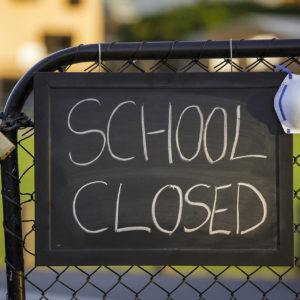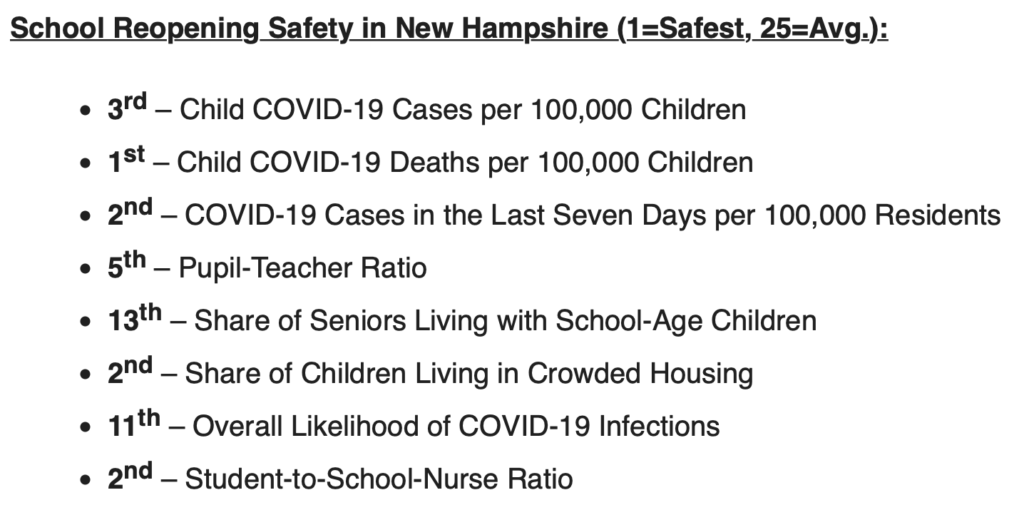A new report ranks New Hampshire’s public schools the fifth safest to reopen in the entire country. And yet fewer than half of them have returned to traditional classroom instruction, leaving many Granite State parents confused and frustrated.
The study, from the data analysts at WalletHub, ranks states by “Risk of COVID-19 Infection” and “Health and Financial Infrastructure.” Among the highlights:
At the same time, nearly one in five New Hampshire school districts are keeping their classrooms entirely closed to students, according to state Department of Education tracking. Another 42 percent of districts are using a hybrid model that allows only parttime classroom instruction. Just 40 percent of districts are open for in-person learning every day.
Local education officials cited fears of students spiking the state’s infection rate as reason to keep classrooms closed, fears that have yet to be realized.
When Concord’s school board voted in August to go to remote-only instruction this fall, board member Gina Cannon said, “I think we have no business going back into the schools right now. We don’t know enough. I think we will see a spike when all the kids come back. I think the hybrid has too many complexities.” The board voted unanimously to go remote only, rejecting the acting superintendent’s recommendation to use a hybrid model.
When the Exeter Cooperative School Board voted 8-1 for fully remote instruction, board member Travis Thompson said the decision to open schools would be “scientific and data-driven.”
And yet the data say it’s safe for schools to open. The state’s COVID-19 schools dashboard lists just two active cases associated with K-12 schools and six recovered cases. The state has not identified any outbreaks at public schools.
The state schools dashboard rates the level of transmission as “minimal” statewide, with only Manchester, Nashua and Strafford County listed as having a “moderate” level of transmission.
This is in line with a steady stream of data from Europe where schools have been open for a month with no reports of outbreaks.
With data showing the risk of transmission so low, and actual illness among children virtually nonexistent, why are these allegedly “data-driven” school systems leaving kids stuck in front of computer screens at home? School officials won’t say.
New Hampshire and its neighboring states, including Massachusetts, are all among the top five safest states for schools to reopen, per the WalletHub report. (Pennsylvania is the other.)
New Hampshire Commissioner of Education Frank Edelblut was pleased by the report.
“We are extremely proud of the work that state and local officials have done over the past several months to bring students back to school safely,” Edelblut told NHJournal. “We will remain vigilant in battling COVID-19 while working to help all New Hampshire students find paths to bright futures.”
Next door in Vermont, Education Secretary Dan French said last week that his state hasn’t seen any transmission at all in its public schools.
And yet, these facts have yet to inspire a rethinking of plans to keep Granite State schools closed, or of models that would make it hard to open schools in the first place.
Democratic nominee for governor Dan Feltes released a back-to-school plan in July with several metrics that would trigger statewide school closures. Among them a 10 percent increase in hospitalizations. “If hospitalizations statewide increase by over 10 percent in a 3-day average,” Feltes wrote, “the entire state would have to shift to remote learning.”
But for most of the past three months, there have been fewer than 10 hospitalizations on any given day. Which means under the Feltes plan, just one additional hospitalized patient would shut down every school in the state.
Feltes’ plan is a victim of the good news in New Hampshire, where positive tests rates are below 1 percent and the state just went ten days without a COVID-19 fatality. But instead of embracing the good news and letting young lives return to normal, many politicians continue to promote new restrictions. In Dover, Rochester, and Somersworth, the mayors are discouraging parents and kids from trick-or-treating this Halloween.
It would be one thing if local leaders were pursuing these protective measures in response to a COVID-19 surge in the schools, or a huge spike in hospitalizations that threatened to overwhelm the system. But there’s no surge, and plenty of hospital bed capacity.
For policies that are supposed to be driven by data and science, some parents say the real force driving local schools is fear.


